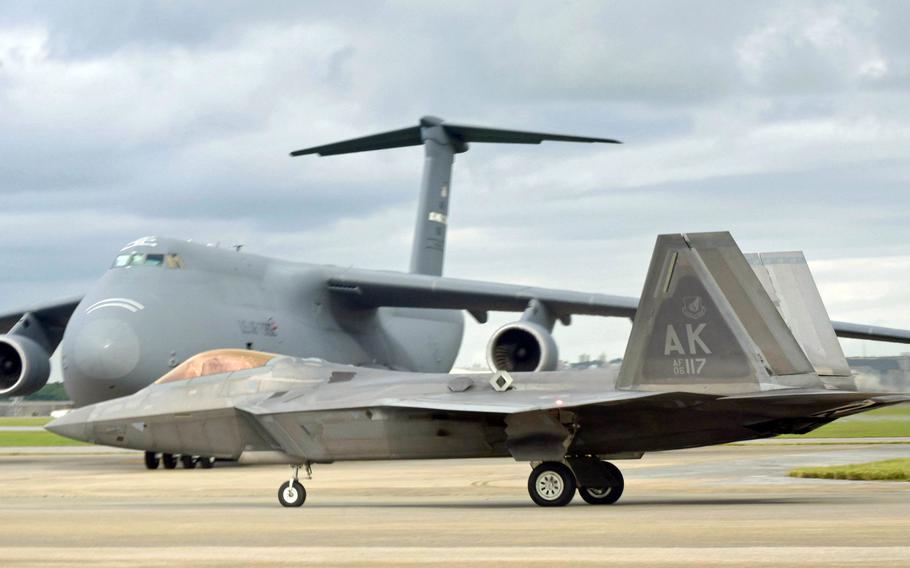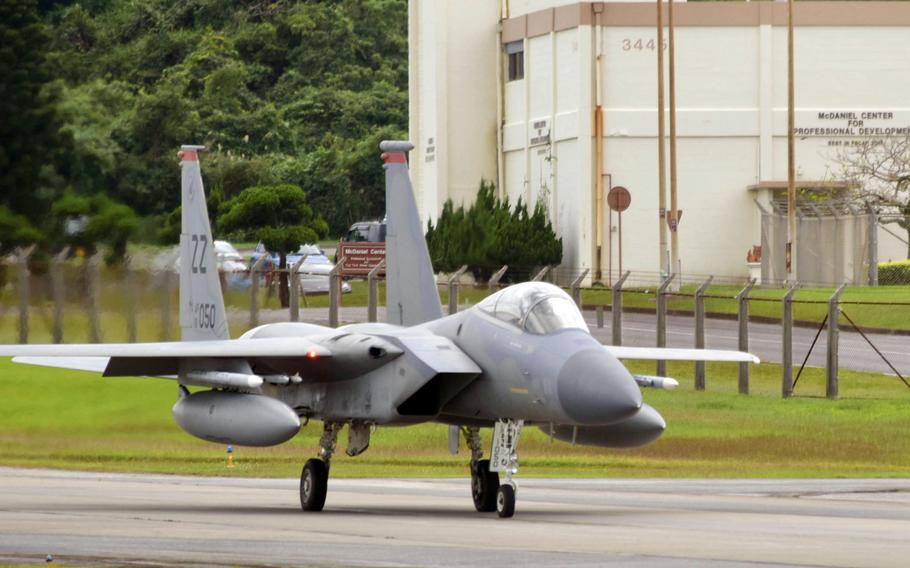
An F-22A Raptor taxies at Kadena Air Base, Okinawa, Tuesday, Nov. 22, 2022. (Frank Andrews/Stars and Stripes)
Replacing fighter squadrons on Okinawa with rotational forces will have negative impacts that will be hard for the Air Force to remedy, according to a former deputy commander of the U.S. Pacific Command.
Retired Air Force Lt. Gen. Dan Leaf in a Nov. 16 interview questioned the two-year phased withdrawal of two squadrons of F-15 Eagle fighters from Kadena Air Base, Okinawa, that began Nov. 1. Alaska-based F-22 Raptors began a rotation at the base on Nov. 4.
A former F-15 pilot himself on Okinawa from 1981 to 1985, Leaf was also deputy commander from 2005 to 2008 of U.S. Pacific Command, now called Indo-Pacific Command.
“I would maintain a permanent air superiority fighter presence in Okinawa if the decision were up to me,” he said, noting the island’s proximity to Taiwan and the Korean Peninsula.
Basing forces on Okinawa has involved difficult negotiations with the prefectural and Japanese governments, Leaf said.
“Removing the F-15s is going to make it very difficult to negotiate a permanent basing of any other planes on Okinawa,” the veteran of combat in Iraq and Kosovo told Stars and Stripes by phone.
“Once they’re gone on a permanent basis, they’re gone,” he said of the fighter squadrons at Kadena. “So permanently basing fighters on Okinawa, for whatever reason we might want to do it, is going to be difficult.”
Kadena’s 18th Wing on Tuesday mobilized 23 F-15C Eagles, eight F-22A Raptors, a trio of HH-60 Pave Hawks, a KC-135 Stratotanker, reconnaissance and command-and-control aircraft in its first large-scale show of force since the F-15s’ phase out began.
Air Force commanders in Japan rely on a fabric of capabilities that includes permanently based and rotational force, Leaf said.
“One thing you do with permanently based forces is build relationships with partners like the Japan Air Self-Defense Force,” he said. “That’s much more difficult to do on a rotational basis.”
The Air Force has had a good mix of permanently based and rotational aircraft in Japan that has served it well for decades, Leaf said.
The departure of the F-15s is “a loss of permanently-based capability and relationship building with Japan … and probably the loss of the ability to do that ever again,” he said.
It’s incorrect, Leaf said, to suggest that bases on Okinawa aren’t survivable in a conflict with China, as claimed by Steve Ganyard, a former deputy assistant secretary of State, in a Nov. 11 email to Stars and Stripes.
“To some degree Okinawa can be defended,” Leaf said. “It needs to be a priority, and it is. There has been significant investment by the U.S. and Japan in the defense of Okinawa and other Japanese territory.”
A pair of Japanese destroyers shot down targets using a new type of defensive missile off Hawaii earlier this month, according to the U.S. Missile Defense Agency.

An F-15C Eagle taxies at Kadena Air Base, Okinawa, Tuesday, Nov. 22, 2022. (Frank Andrews/Stars and Stripes)
Rotational forces on the island bear the same risk as permanently stationed aircraft, Leaf said.
“Just because they’re rotational doesn’t give them some sort of cloaking device or make it easy to teleport them to some other location in the Indo-Pacific,” he said.
The F-15 is still a capable plane but very old, Leaf said.
“Of all the fourth-generation aircraft, only one has a 104-0 record in aerial combat,” he said. “I would not [mess] with an F-15 if I was a Chinese pilot.”
But the Air Force has not invested enough to replace the F-15, Leaf said. For example, the service had requested hundreds of F-22s but only bought 183, he said.
“We knew 20 years ago that wasn’t enough,” he said.
Whatever the rationale for the removal of the F-15s from Okinawa, the Chinese will see it as a withdrawal, Leaf said.
“It is a lack of commitment in their minds,” he said. “In terms of deterrence it’s a net negative. That element can’t be undone by saying we are going to rotate, or the planes are more capable.”
Leaf isn’t alone in his criticism of the move. Prominent Republican lawmakers sent a letter to Defense Secretary Lloyd Austin on Nov. 1, saying they feared a “tangible reduction in American forward combat power.”
There should be a permanent Air Force fighter presence on Okinawa but the F-15s are too old and need to be shelved, according to Riki Ellison, founder of the Missile Defense Advocacy Alliance, which lobbies for missile defense, deployment and development.
“We have no choice but to place F-22s and F-35s in rotation until we get a new set of planes to place there,” he said in an email Tuesday. “We have to play with what we got until we get more.”
However, a move to rotational units on Okinawa “in concert with upgraded Japanese tactical air assets may not be a diplomatically problematic move,” Paul Buchanan, a U.S. security expert based in New Zealand, said by email Tuesday.
The move reflects the fact that Japan is assuming a more robust military posture, to include proposed changes in its pacifist constitution, he said.
“The loss of F-15s can be compensated by Japanese forces as well as whatever the US brings in as a stop gap,” he said. “Tactical airpower numbers will remain robust no matter what actually happens.”